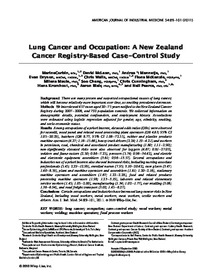Lung cancer and occupation: a New Zealand Cancer Registry-based case-control study

Corbin, Marine ; McLean, David ; 't Mannetje, Andrea ; Dryson, Evan ; Walls, Chris ; McKenzie, Fiona ; Maule, Milena ; Cheng, Soo ; Cunningham, Chris ; Kromhout, Hans ; Blair, Aaron ; Pearce, Neil
American Journal of Industrial Medicine
2011
54
2
89-101
case control study ; food worker ; lung cancer ; metalworker ; occupation disease relation ; registers of occupational diseases ; woodworker ; welder
Occupational diseases
English
Bibliogr.
"BackgroundThere are many proven and suspected occupational causes of lung cancer, which will become relatively more important over time, as smoking prevalence decreases.MethodsWe interviewed 457 cases aged 20–75 years notified to the New Zealand Cancer Registry during 2007–2008, and 792 population controls. We collected information on demographic details, potential confounders, and employment history. Associations were estimated using logistic regression adjusted for gender, age, ethnicity, smoking, and socio-economic status.ResultsAmong occupations of a priori interest, elevated odds ratios (ORs) were observed for sawmill, wood panel and related wood-processing plant operators (OR 4.63; 95% CI 1.05–20.29), butchers (OR 8.77, 95% CI 1.06–72.55), rubber and plastics products machine operators (4.27; 1.16–15.66), heavy truck drivers (2.24; 1.19–4.21) and workers in petroleum, coal, chemical and associated product manufacturing (1.80; 1.11–2.90); non-significantly elevated risks were also observed for loggers (4.67; 0.81–27.03), welders and flame-cutters (2.50; 0.86–7.25), pressers (5.74; 0.96–34.42), and electric and electronic equipment assemblers (3.61; 0.96–13.57). Several occupations and industries not of a priori interest also showed increased risks, including nursing associate professionals (5.45; 2.29–12.99), enrolled nurses (7.95; 3.10–20.42), care givers (3.47; 1.40–8.59), plant and machine operators and assemblers (1.61; 1.20–2.16), stationary machine operators and assemblers (1.67; 1.22–2.28), food and related products processing machine operators (1.98; 1.23–3.19), laborers and related elementary service workers (1.45; 1.05–2.00), manufacturing (1.34; 1.02–1.77), car retailing (3.08; 1.36–6.94), and road freight transport (3.02; 1.45–6.27).ConclusionsCertain occupations and industries have increased lung cancer risks in New Zealand, including wood workers, metal workers, meat workers, textile workers and drivers."
Digital
The ETUI is co-funded by the European Union. Views and opinions expressed are however those of the author(s) only and do not necessarily reflect those of the European Union or the ETUI.